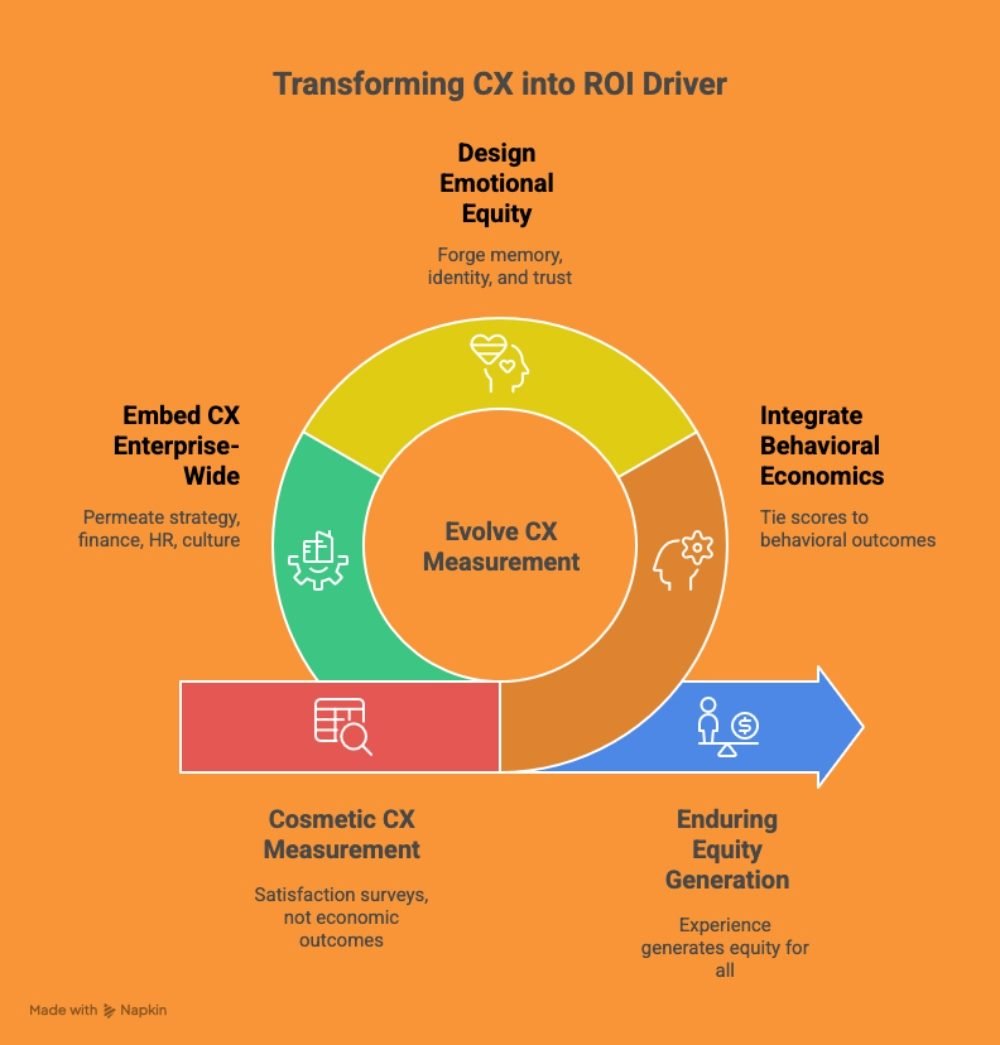The Gist
- Beyond vanity metrics. CSAT and NPS alone don’t prove ROI — leaders must connect CX to hard business outcomes like retention, revenue and churn reduction.
- Emotional equity as value. Operational efficiency is table stakes; differentiation comes from experiences that build trust, loyalty and long-term brand resilience.
- Enterprise-wide discipline. CX cannot remain siloed — it must permeate strategy, finance, HR, and culture to create measurable, enduring impact.
Being a digital immigrant helps! I have observed, for over two decades, that CX has been celebrated as the golden lever of brand growth. From NPS dashboards to omnichannel journeys, organizations have invested substantially in systems and teams to “delight” customers.
Yet, as global leaders sharpen their pencils on ROI, I still keep asking this uncomfortable question arises: Has CX truly justified its promise of financial impact?
The truth is complex. CX has indeed created differentiation, but much of its measurement has remained cosmetic — leaning on satisfaction surveys and service resolutions rather than connecting deeply to economic outcomes.
As markets shift toward experience-driven commerce, the next decade demands a more mature view: CX must evolve from a “soft” function into a disciplined driver of ROI, with academic rigor and critical analysis backing its claims.
Embracing optimism, I thought of penning my observations on three future-looking shifts that industry leaders must confront if CX is to keep strengthening hold its place at the strategy table.
Table of Contents
- 1. From Metrics to Meaning: Redefining Measurement
- 2. From Efficiency to Emotional Equity: Designing Experiences That Compound Value
- 3. From Department to Discipline: Embedding CX Into Enterprise DNA
- CX Is a Hard Science of Value Creation
- Our Take: Satisfaction Is Not Enough
- Beyond Satisfaction Scores: CX Leaders Rethink ROI
- The Limitations of Traditional Metrics
- AI-Powered Analytics Drive Continuous Insights
- New Metrics Emerge
- Long-Term Value Focus
1. From Metrics to Meaning: Redefining Measurement
Traditional CX measurement has been dominated by numerical scores — CSAT, NPS, CES. While useful, these metrics often operate as proxies for sentiment rather than predictors of business impact. Academic research increasingly highlights that such scores are weakly correlated with financial performance unless tied to behavioral outcomes like repeat purchases, share of wallet or customer lifetime value.
The future lies in integrating behavioral economics with CX analytics. Instead of asking “Did the customer feel satisfied?” the sharper question is “Did the experience alter behavior in ways that generate long-term value?” For example, reducing friction in a subscription renewal journey may not lift NPS dramatically but could directly enhance retention rates and recurring revenue.
Leaders who continue to fetishize scores without translating them into economic levers risk making CX ornamental, not operational.
2. From Efficiency to Emotional Equity: Designing Experiences That Compound Value
CX has often been reduced to efficiency — faster service, smoother checkouts, shorter calls. While operational hygiene is essential, it rarely creates distinctiveness. In fact, many competitors now benchmark on the same metrics, leaving little space for differentiation.
Future-ready CX must pivot toward emotional equity — designing experiences that forge memory, identity and trust. Neuroscience shows that emotionally charged experiences are remembered longer and influence decision-making more deeply than transactional ones. For ROI, this translates into reduced price sensitivity, increased advocacy and stronger brand resilience in downturns.
Well, consider the difference between a seamless airline check-in app (expected hygiene) and a proactive alert that rebooks a traveler mid-disruption with empathy and choice (unexpected equity). The latter builds loyalty that compounds into measurable ROI. The academic challenge here is to model intangible emotions into tangible outcomes — a frontier that behavioral sciences and marketing science are beginning to address.
Related Article: The Loyalty Equation: Trust + Context + Community
3. From Department to Discipline: Embedding CX Into Enterprise DNA
Too often, CX is treated as a siloed department, tasked with firefighting or post-purchase surveys. This structure is a fundamental misstep. Research across service industries shows that sustainable CX impact emerges when it is embedded into enterprise design — from product development to pricing strategy, from HR policies to investor communication.
In the near future, ROI attribution may demand systems thinking, such as how does a cultural decision on employee empowerment ripple into customer advocacy? How does a pricing model designed for transparency reduce churn? How do ESG commitments shape perceptions of brand authenticity? CX cannot be confined to the customer support desk; it must become a discipline that permeates every strategic choice.
For academia, this shift signals fertile ground: cross-disciplinary research linking CX with finance, strategy and organizational behavior. For leaders, it demands courage — to stop outsourcing CX to dashboards and start owning it as an enterprise philosophy.
CX Is a Hard Science of Value Creation
In my opinion, the critical challenge is to treat CX not as the soft edge of marketing but as the hard science of value creation. In my opinion, the organizations that keep succeeding will be those that dare to ask not “Was the customer happy?” but “Did the experience generate enduring equity for both the customer and the company?”

Our Take: Satisfaction Is Not Enough
Traditional metrics like CSAT and NPS may tell you if a customer felt good in the moment, but they don’t show if that satisfaction translated into renewal, loyalty or revenue growth. To prove ROI, CX leaders must measure experiences against hard business outcomes — retention, lifetime value and reduced churn. Anything less risks painting a feel-good picture with little financial impact.
Here's what we're seeing in this arena of customer experience over the past year:
Beyond Satisfaction Scores: CX Leaders Rethink ROI
Customer experience measurement is shifting from traditional satisfaction metrics to business outcome-focused approaches as organizations seek tangible returns on their CX investments.
The Limitations of Traditional Metrics
Companies are moving beyond simple CSAT and NPS scores, recognizing that satisfaction bumps mean little unless they translate into measurable business results like improved retention, revenue growth or reduced churn.
Leading organizations including HubSpot and Adobe now blend traditional satisfaction scores with outcome-focused metrics such as net revenue retention and renewal rates. This approach ensures CX initiatives connect directly to business KPIs and that experience improvements drive measurable value.
AI-Powered Analytics Drive Continuous Insights
are helping companies transition from episodic surveys to continuous, actionable insights. This shift allows for proactive interventions before customer dissatisfaction escalates.
The evolution represents a fundamental change in how organizations view CX ROI. Rather than focusing solely on customer happiness, companies are prioritizing business health outcomes.
New Metrics Emerge
Research from Deloitte indicates that customer-centric companies demonstrate significantly higher profitability. Meanwhile, Gartner and other analysts advocate for new metrics including value enhancement scores and journey friction indexes.
These advanced metrics move beyond satisfaction questions to measure whether customer experiences helped clients achieve more, reduced effort or created loyalty.
Long-Term Value Focus
In an environment where customer acquisition costs continue rising, CX leaders are rethinking their ROI approach. The focus is shifting toward long-term relationships and lifetime value rather than short-term satisfaction scores.
According to industry analysts, organizations that limit their CX strategy to satisfaction metrics risk missing broader business opportunities and real returns on their customer experience investments.
Learn how you can join our contributor community.
